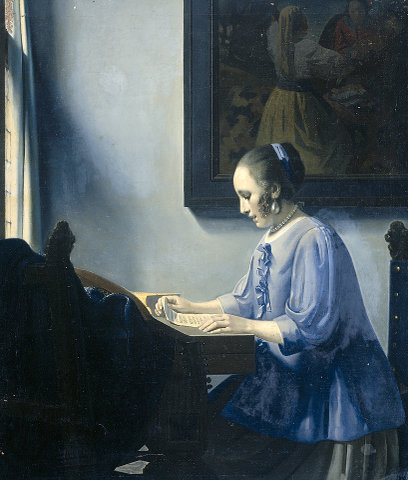In a hushed seventeenth-century interior a young girl is reading a sheet of music. The neck of her lute can be seen in silhouette beside her. Sunlight floods through the leaded glass of the window at which she sits. The artist has taken particular care over the highlights in her pearl earring and necklace. In anticipation of the main exhibtion at the National Gallery this summer, “Vermeer and the School of Delft” this week’s picture is Vermeer’s own incomparable Woman Reading Music.
April Fool! In fact, the picture is by one of the most celebrated hoaxers of the twentieth century, Henricus Antonius “Han” van Meegeren. Van Meegeren created more than half a dozen fake Vermeers in the 1930s and 1940s, successfully passing several of them off as the real thing, and earning himself a fortune in the process. Leading collectors of the day paid the equivalent of many millions of pounds for Van Meegeren’s “Vermeers”. By the time he was unmasked, in 1945, he was found to be in possession of huge amounts of paper money – hard cash that was necessary, in wartime Holland, to feed his prodigious appetite for alcohol, drugs and prostitutes.
“The Van Meegeren Affair”, as it came to be known, reflected badly on the self-styled connoisseurs who had collected the faker’s work with such naïve enthusiasm; and even worse on their advisers, who included many of the leading Dutch art scholars of the day. Indeed one of Van Meegeren’s principal motives for forging Vermeer’s work was the desire to humiliate the critics and art historians who had so signally failed to recognise his own talent. An embittered and mediocre painter of lifeless boardroom portraits, unpleasant soft-porn fantasies and saccharine sweet animal paintings – an especially execrable example of which, The Deer, was for...

ITP 50: Woman Reading Music, by Han van Meegeren
01-04-2001

